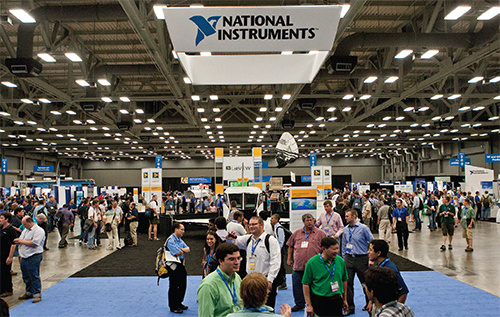
This year’s National Instruments’ NI Week in Austin, Texas was the biggest yet, with more than 3,000 attendees descending on the Live Music Capital of the World, turning it into the international capital for graphical system design. Following are some thoughts from four of our editors who attended the event.

Paul J. Heney
Editorial Director
My first NI Week was a fascinating one, what with the 25th anniversary of LabVIEW, NI’s successful LabVIEW engineering design software for measurement and control, and the launch of LabVIEW 2011. The Tuesday afternoon session with the NI executive team offered a rare view into their business philosophy of executing a logical, R&D-focused, long-term strategy. That strategy—and the resulting steady returns—allows the company to operate reasonably outside the “What have you done for me this quarter?” mentality that drives so many banker/investment types on Wall Street.
I learned a great deal about the RIO technology platform and how the architecture of the system is being used by engineers in a wide variety of applications—including energy storage, renewable energy, oil and gas, and industrial robotics. And it was a pleasant surprise to discover the trade show floor’s myriad application stories. Walking down the aisle, attendees could peruse examples of partner companies who have used LabVIEW to solve and expedite their engineering challenges. Seeing wind power solutions next to medical applications beside a full-sized next-generation space shuttle was a truly powerful illustration of the power and flexibility of the software.

Miles Budimir
Senior Editor, Motion Control
LabVIEW co-developer Jeff Kodosky reflected on the early days of the software and took a peek into the future to speculate on which way LabVIEW might evolve over the next 25 years. The continued evolution of LabVIEW combined with developments on the hardware side mean ever-more powerful engineering design tools. Case in point is NI’s announcement of the latest CompactRIO (real-time I/O) controller. The 908x family features an Intel Core i7 dual-core 1.33 GHz processor and a Xilinx Spartan-6 FPGA (field programmable gate array).

You can use the LabVIEW FPGA Module to create custom measurement and control hardware using graphical programming without having expertise in low-level hardware description languages. The custom hardware supports applications requiring high-speed hardware reliability and tight determinism and can be used for unique timing and triggering, ultra high-speed control, interfacing to digital protocols, and many other tasks.
For designers, the cRIO 908x family lets you take your measurement and control applications to a whole new level with the impressive amount of processing power available here. The range of applications presented at NI Week ran the gamut from a milk refrigeration system for rural areas of India where the electricity supply is unreliable to increasing the imaging speed and reducing the size of an optical coherence tomography (OCT) imaging system.
Needless to say, I’m looking forward to next year’s NI Week and seeing what challenges engineers have overcome and what new ones lie ahead.

Joe Gorse
Electrical Engineering Editor
From Lego MindStorms to the Tokamak fusion reactor and the Large Hadron Collider, National Instruments continues to broaden the reach of their portfolio of platformed Test, Measurement, & Automation products while improving technical performance to or beyond the current state of the art. NI Week delivered high value content, new cutting-edge products, and an injection of adrenaline in the realm of “Do engineering.”

Most interesting to me were the applications, showing the NI way of engineering. These included innovation in health care and automotive R&D. We even saw the famed storm chaser, Tim Samaras, and the evolution of NI hardware in his probes through the years. There were awe-striking images and data of tornadoes and lightning. When asked what the Holy Grail of sensors would collect in the future from tornadoes, Tim replied the point wind velocities before formation, at the genesis, during, and after dissipation.
I was also impressed with NI’s academic programs—both within universities and high schools. We heard about a design competition with more than 19 countries and 100 projects submitted. The final four were presented in Austin.

Paul Dvorak
Editoral Director, Windpower Engineering
If any state appreciates power from renewable energy, it’s Texas, home to more wind turbines than any other state. So it makes sense that the Smart Grid got top billing at this conference. During the Wednesday keynote, Jaswinder Singh told of how the Indian state of Rajasthan loses about 35% of the power its utility produces. Most of it is stolen or unmetered and Singh had pictures to prove it.
Singh, a member of India-based NextGen Consultants, will work with the utility to improve its monitoring of power from substations into communities. Line sensors will be wired to NI Compact Rio devices that will send monitored signals to a central station for analysis.
Condition monitoring earned a session this year with two presentations, from Youngkey Kim and then Dr. Mohamed AbuAli of the University of Cincinnati. Kim showed a graph of turbine outputs versus wind speed. Usually, such a curve is narrow and S-shaped. Kim’s curves, actual readings, were wide swaths indicating turbines performing less than their best. Kim then showed how an analysis of SCADA data could provide some diagnosis. A next step would be to modify the control software and test it in LabVIEW to avoid a sub-par performance.
AbuAli told more of what a wind farm operator might do for underperforming turbines. For instance, by grouping a wind farm’s top five turbines and worst performing five, the data from the top units provide a template to diagnose the others. He called these tactics Prognostic Health Monitoring. What’s more, AbuAli and colleagues have developed about 20 algorithms for specific turbine controls functions developed with NI’s LabVIEW.

Filed Under: Factory automation, Green engineering • renewable energy • sustainability, ENGINEERING SOFTWARE, Energy management + harvesting, Motion control • motor controls, Mechatronics





Tell Us What You Think!